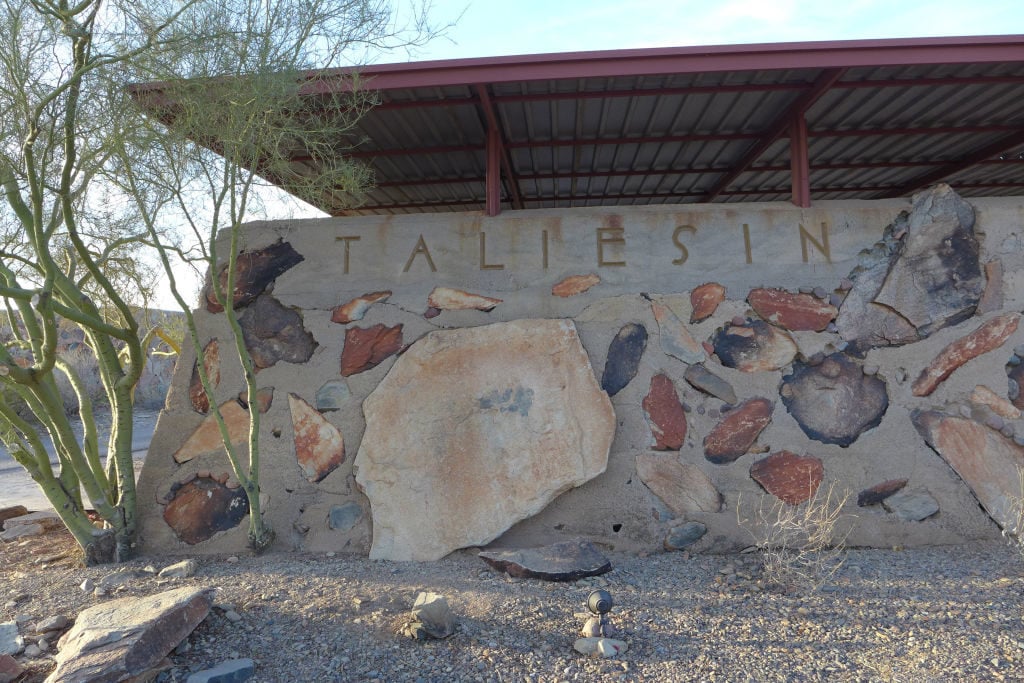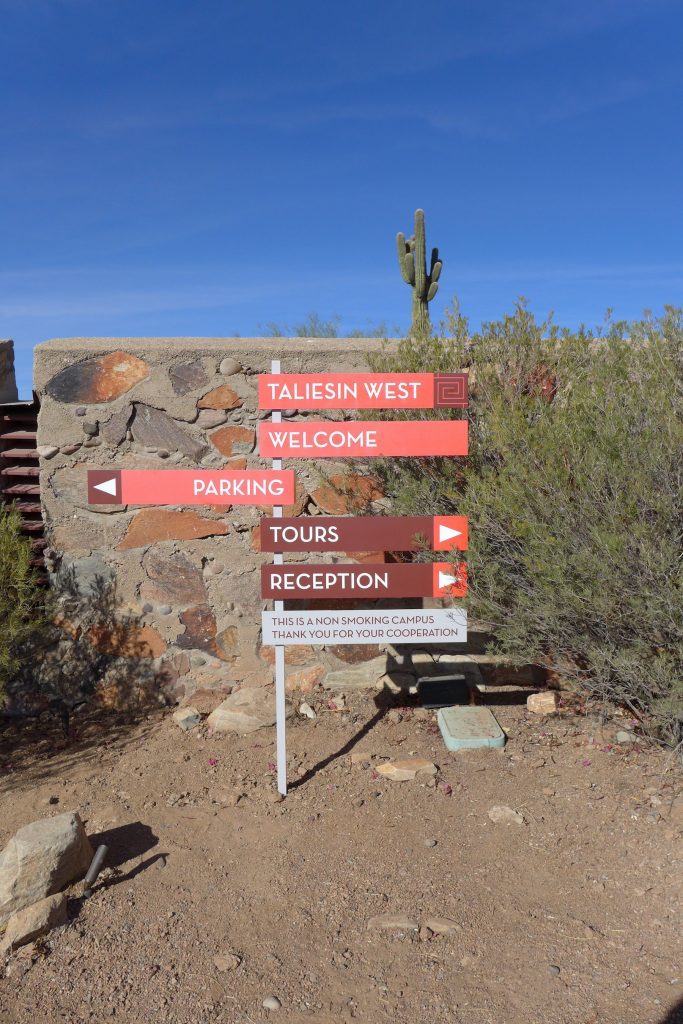Taliesin West, Frank Lloyd Wright’s former winter home, sits in the desert of Scottsdale, Arizona. In 1932, the American architect and his wife Olgivanna established a fellowship program, endorsed by luminaries like Albert Einstein, Buckminster Fuller, Georgia O’Keeffe, Diego Rivera, and Mies Van Der Rohe. Based on Wright’s fairly radical vision of education, the resulting school has allowed its students to build and reside in their own shelters, so they can gain insight into the real-world repercussions of their designs.
Last month, it was announced that the School of Architecture at Taliesin would move and take a new name, partnering now with the Cosanti Foundation—a dramatic change that symbolically and spatially severs the connection to Wright. The move came in the wake of a January 25 decision by the Frank Lloyd Wright Foundation to close the school, saying that it would not renew its memorandum of understanding which allowed the institution to operate at Taliesin. (Since 2017, the foundation and the school have been separate entities, with the school remaining a wholly owned subsidiary of the foundation; both occupied the grounds of Taliesin West and the foundation essentially acted as the school’s landlord.)

Promotional image showing students at School of Architecture at Taliesin. Image courtesy SoAT.
In the shadow of the complicated, acrimonious back-and-forth between the school and foundation about the future of the partnership, the current class of graduate students, who were told they could finish their degrees at Arizona State University, had started to organize. They posted a petition that gained over 30,000 signatures and started to publicly criticize the foundation.
Meanwhile, behind the scenes, Artnet News has learned that tensions have been fueled by a widespread sense of a deeply abusive culture from the Frank Lloyd Wright Foundation’s top management.
In interviews, two students and five former employees of the foundation have made allegations of intimidation, threatening comments, retaliation, and a hostile work environment against Stuart Graff, the Frank Lloyd Wright Foundation’s current CEO and president. Graff’s alleged behavior includes screaming, belittling, and intimidating staff, threatening lawsuits against critics, and firing employees or forcing them out for criticizing his leadership.
As one former employee, who wishes to remain anonymous, put it, “There’s a real climate of fear at the organization.”
Graff did not respond to repeated requests for interviews by Artnet News. All requests were routed to the press representative for the foundation. In response to a series of 45 questions sent by email addressing the specific allegations, Graff issued the following statement via the representative:
The statements sent are a mix of false, inaccurate and incomplete depictions. I acknowledge that I’ve said some intemperate things at moments where my passion for our work overtook my professional judgment in dealing with individuals. I hold myself to a higher standard, professionally and personally; I apologize for not always living up to those expectations and commit to doing better. Yet, many of these allegations seem part of an orchestrated [sic] a campaign to blame the failure and closure of the School of Architecture on the Foundation, and, more specifically, on me. At this time, my focus is to navigate the impact of the worldwide pandemic on the Foundation’s mission and operations; and my concern is for our staff, some of whom have been furloughed or taken substantial cuts in pay due to our closure. I’m proud of our team and its close collaboration, whose work in these stressful times has engaged the public with Wright’s work in new and exciting ways; it is not a good use of my time to address specious accusations when there is more work to be done.
An Ugly Environment
Christina Anderson, executive assistant to Graff from May 2017 to October 2018, told Artnet News that she was aware of numerous complaints against him—about 15 a week while she was there, although she is not sure how many were formally reported to Human Resources.
Graff fired or forced out “at least 20” employees because they spoke up against him, Anderson said. “It was one of those things that, if he didn’t agree with them, and they had that conflict, he may not fire them on the spot because he didn’t have cause—but if he didn’t have cause he would make their work life a living hell until they quit.”
Based on interviews and a review of employee information on LinkedIn, 20 people have left since Graff started as CEO and president in February 2016, including one chairman of the board, two VPs of licensing, one chief operating officer, one chief philanthropy officer, one chief development officer, one VP of development and communications, two executive assistants, a director of events, two directors of technology, one human resources director, one HR manager, two facilities managers, one event manager, an event coordinator, a manager of retail operations, and a paralegal.

Frank Lloyd Wright’s Taliesin West in Scottsdale, Arizona on December 9, 2017. Photo: Jim Steinfeldt/Michael Ochs Archives/Getty Images.
An attempt to allow staff to express criticism via survey proved counterproductive. “Stuart could see the staff responses,” Anderson explained. “It was a survey done through Survey Monkey and even though it was supposed to be anonymous, you could tell who sent it by their responses, which department they worked for and/or the IP address of the computer they used. He used it to make their work life harder to push them out.”
“If not for the toxic atmosphere at the organization, I would’ve happily stayed,” Amy Flynn, director of technology for the foundation from July 2017 to November 2019, told Artnet News.
Several other former employees spoke with Artnet News on condition of anonymity and confirmed the behavior. “He would just yell, ‘You’re stupid, you don’t know what you’re doing, you don’t know how to do this. You’re a moron,’” said one. Another recounted an interaction with Graff that included “red-in-the-face yelling” that left them “stunned and shaking.”
A former member of the foundation’s leadership team, who also wishes to remain anonymous, painted a similar picture. “The reason I loved working at the Frank Lloyd Wright Foundation is because it was very much like a quirky family, and I think the school’s an extension of that, and so everybody really cared deeply about each other. All of that just kind of changed under his leadership. It was very much about corporate backbiting, a tear-everybody-else-down kind of mentality.”
Anderson claims that Graff’s behavior was widely known, if not addressed at the board level. This changed somewhat, she noted, in January 2018, when the board held a meeting without Graff where it was decided that he would be assigned a job coach. “That’s part of why I could stay a little bit longer, but it was just kind of… it put a Band-Aid on it, but it didn’t heal it,” Anderson said.

Frank Lloyd Wright’s Taliesin West in Scottsdale, Arizona on December 9, 2017. Photo by Jim Steinfeldt/Michael Ochs Archives/Getty Images.
(Another former foundation employee who wished to remain anonymous said that in May 2019, at the behest of the foundation’s board, an investigation into Graff’s behavior was conducted by Laura Alexander, of Alexander Carrillo Consulting, which included interviews with foundation employees and a staff survey. It is unclear what led to this alleged investigation, and Artnet News’s request for an interview with the firm was turned down.)
“You’re a Nobody”
Students of the now-decoupled Architecture School, too, describe sometimes explosive encounters with Graff over seemingly small details.
Alex Martinec, a 33-year-old graduate student, moved to Taliesin West in 2019 with his fiancé and their dog. On November 15, 2019, Martinec was walking to a student meeting, when, he says, he saw Graff. According to Martinec, prior to this, he and Graff had been emailing about where the animal, which is a certified emotional support dog, could and couldn’t be on campus.
Since they hadn’t met in person yet, Martinec introduced himself. The subject of whether the dog should be allowed on the grounds came up and turned contentious, he said: “He told me multiple times to go ‘f’ myself, on the property, to my face, yelling at me.” In Martinec’s account, Graff then yelled, “Who are you? You’re nobody.” As Martinec recalls, “I tried to respond in that moment. I said, ‘I’m a student here.’ And he said, ‘No, you’re a nobody… I’m the CEO of the foundation.’”
During the encounter, Martinec says Graff threatened to make life harder for him and his fiancé at the school.
The major details of the interaction between Martinec and Graff were corroborated by an incident report Martinec filed that day, which was seen by Artnet News. Two students and three school employees who saw Martinec immediately after the incident, one of whom is Aaron Betsky, the outgoing president of the school, also confirmed seeing Martinec dramatically shaken. “He came upstairs to where we were all sitting right after that in tears,” Betsky said.
Punishing Students
The students at Taliesin provided tours of the shelters they built in order to generate revenue for student activities. In January, after the school voted to close, students started speaking to the media, including in a January 30 article in USA Today.

In progress image of student Taylor Bode’s shelter, from the school website. Image courtesy SoAT.
That same day, in an email seen by Artnet News, Graff wrote to school president Betsky: “I have now heard that the students are endeavoring to interact with our tour guests during tour operations. And that they are being offered to the press (again). We’ll be not be [sic] restarting the shelter tours until it’s very clear that such conduct—clear violations of the MOU [memorandum of understanding]—is halted. Using the students as props is just disgraceful. Shame on you.”
In response, Betsky denied “offering up the students” to the press.
Michele Yeeles, a second-year graduate student, says she was able to convince the foundation to allow the tours to resume, and that they were restored on February 20. But then another problem arose. On February 26, Yeeles spoke with Ellen Solowey at the Virginia Piper Trust, an organization that is a donor to the Frank Lloyd Wright Foundation.
Yeeles says she called “to inquire about a grant that the foundation had received. I’d just called to ask some questions about it, what it was for, if there would be any public-produced documents, things like that. And the woman on the phone got extremely nervous.”
Later that afternoon, Yeeles says she was in the studio at Taliesin West when Graff showed up with Kevin Conley, vice president of public engagement with the foundation (Conley did not respond to a request for comment, and forwarded Artnet News’s request to the PR firm). Graff asked to speak with Yeeles, suggesting the conversation would be about the shelter tours.
Once they stepped outside, Yeeles says Graff brought up the call to Virginia Piper Trust, and promptly informed her that the shelter tours were cancelled again.
Yeeles sees the move as a form of collective punishment of the entire student body. “He shut it down because of something that I did personally in my own time as a private citizen with a right to free speech and investigation, as far as I was aware,” Yeeles said.
Lingering Questions
Graff, who has called himself a “recovering corporate attorney and business leader,” received $267,576 in compensation in 2018, according to the latest tax form available through ProPublica.
With the onset of COVID-19, several foundation employees were furloughed or had their pay cut. Neither Graff nor his PR representative responded to specific questions regarding this, or to questions regarding whether Graff’s own pay was cut. It is unclear what repercussions resulted from his encounter with students Alex Martinec and Michele Yeeles and the subsequent incident reports that were filed.
With the move of the School of Architecture to the Cosanti Foundation, the breakup between school and foundation is complete. For its part, the school promises to continue the distinctive legacy of Frank Lloyd Wright’s pedagogy, albeit in new circumstances and without the direct connection to Taliesin West. As for the foundation, it remains where it was, but with questions over whether business as usual can—or should—go on.












